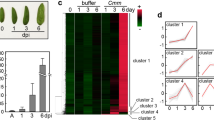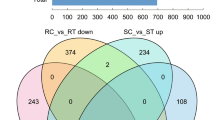Abstract
Lectin receptor-like kinases (LecRLKs) are crucial factors in response to plant biotrophic pathogens. This study aimed to systemically analyze the effect of tomato LecRLKs on the responses to tomato yellow leaf curl virus (TYLCV) infection. A total of 93 tomato SlyLecRLK genes, including 69 G-type LecRLKs, 23 L-type LecRLKs, and one C-type LecRLK, were identified using genome-wide analysis and were clustered into three subfamilies using phylogenetic analysis. These SlyLecRLK genes were localized on the 12 tomato chromosomes with some gene duplication events. Transcriptomic analysis showed most of SlyLecRLKs were modulated by phytohormones and TYLCV infection. Gene ontology (GO) enrichment analysis showed all SlyLecRLK genes were associated with receptor protein kinase activity and protein modification. Quantitative RT-PCR (qRT-PCR) and gene interference validation showed SlyLecRLKs007, SlyLecRLKs036, and SlyLecRLKs044 genes were inhibited by TYLCV infection, and silencing of them were accompanied by accumulation of TYLCV DNA content. Subcellular localization of LecRLKs023 and LecRLKs044 on cell membranes was determined using a SlyLecRLK-containing A. tumefaciens strain GV3101. These results showed SlyLecRLK genes were key factors for TYLCV resistance, and also provided crucial information uncovering the protective effects of SlyLecRLKs on resisting TYLCV infection in tomato.








Similar content being viewed by others
References
Bonaventure G (2011) The Nicotiana attenuata LECTIN RECEPTOR KINASE 1 is involved in the perception of insect feeding. Plant Signal Behav 6:2060–2063
Bouwmeester K, Govers F (2009) Arabidopsis L-type lectin receptor kinases: phylogeny, classification, and expression profiles. J Exp Bot 60:4383–4396
Bowers JE, Chapman BA, Rong J, Paterson AH (2003) Unravelling angiosperm genome evolution by phylogenetic analysis of chromosomal duplication events. Nature 422:433
Chen X, Shang J, Chen D, Lei C, Zou Y, Zhai W, Liu G, Xu J, Ling Z, Cao G, Ma B, Wang Y, Zhao X, Li S, Zhu L (2006) A B-lectin receptor kinase gene conferring rice blast resistance. Plant J 46:794–804
Chen T, Lv Y, Zhao T, Li N, Yang Y, Yu W, He X, Liu T, Zhang B (2013) Comparative transcriptome profiling of a resistant vs. susceptible tomato (Solanum lycopersicum) cultivar in response to infection by tomato yellow leaf curl virus. PLoS One 8:e80816
Deng K, Wang Q, Zeng J, Guo X, Zhao X, Tang D, Liu X (2009) A lectin receptor kinase positively regulates ABA response during seed germination and is involved in salt and osmotic stress response. J of Plant Bio 52:493
Du Z, Zhou X, Ling Y, Zhang Z, Su Z (2010) agriGO: a GO analysis toolkit for the agricultural community. Nucleic Acids Res 38:W64–W70
Gilardoni PA, Hettenhausen C, Baldwin IT, Bonaventure G (2011) Nicotiana attenuata LECTIN RECEPTOR KINASE1 suppresses the insect-mediated inhibition of induced defense responses during Manduca sexta herbivory. Plant Cell 23:3512–3532
Gouhier-Darimont C, Schmiesing A, Bonnet C, Lassueur S, Reymond P (2013) Signalling of Arabidopsis thaliana response to Pieris brassicae eggs shares similarities with PAMP-triggered immunity. J Exp Bot 64:665–674
Hofberger JA, Nsibo DL, Govers F, Bouwmeester K, Schranz ME (2015) A complex interplay of tandem- and whole-genome duplication drives expansion of the L-type lectin receptor kinase gene family in the Brassicaceae. Genome Biol Evol 7:720–734
Huang P, Ju H-W, Min J-H, Zhang X, Kim S-H, Yang K-Y, Kim CS (2013) Overexpression of L-type lectin-like protein kinase 1 confers pathogen resistance and regulates salinity response in Arabidopsis thaliana. Plant Sci 203-204:98–106
Letunic I, Doerks T, Bork P (2012) SMART 7: recent updates to the protein domain annotation resource. Nucleic Acids Res 40:D302–D305
Liu Y, Wu H, Chen H, Liu Y, He J, Kang H, Sun Z, Pan G, Wang Q, Hu J, Zhou F, Zhou K, Zheng X, Ren Y, Chen L, Wang Y, Zhao Z, Lin Q, Wu F, Zhang X, Guo X, Cheng X, Jiang L, Wu C, Wang H, Wan J (2014) A gene cluster encoding lectin receptor kinases confers broad-spectrum and durable insect resistance in rice. Nat Biotechnol 33:301
Mühlhausen S, Kollmar M (2013) Whole genome duplication events in plant evolution reconstructed and predicted using myosin motor proteins. BMC Evol Biol 13:202
Obara K, Yamamoto H, Kihara A (2012) Membrane protein Rim21 plays a central role in sensing ambient pH in Saccharomyces cerevisiae. J Biol Chem 287:38473–38481
Shiu S-H, Bleecker AB (2001) Plant receptor-like kinase gene family: diversity, function, and signaling. Sci STKE 2001:re22–re22
Singh P, Kuo Y-C, Mishra S, Tsai C-H, Chien C-C, Chen C-W, Desclos-Theveniau M, Chu P-W, Schulze B, Chinchilla D, Boller T, Zimmerli L (2012) The lectin receptor kinase-VI.2 is required for priming and positively regulates Arabidopsis pattern-triggered immunity. Plant Cell 24:1256–1270
Sun X-L, Yu Q-Y, Tang L-L, Ji W, Bai X, Cai H, Liu X-F, Ding X-D, Zhu Y-M (2013) GsSRK, a G-type lectin S-receptor-like serine/threonine protein kinase, is a positive regulator of plant tolerance to salt stress. J Plant Physiol 170:505–515
Trapnell C, Pachter L, Salzberg SL (2009) TopHat: discovering splice junctions with RNA-Seq. Bioinformatics 25:1105–1111
Trapnell C, Roberts A, Goff L, Pertea G, Kim D, Kelley DR, Pimentel H, Salzberg SL, Rinn JL, Pachter L (2012) Differential gene and transcript expression analysis of RNA-seq experiments with TopHat and Cufflinks. Nat Protoc 7:562–578
Vaid N, Pandey PK, Tuteja N (2012) Genome-wide analysis of lectin receptor-like kinase family from Arabidopsis and rice. Plant Mol Biol 80:365–388
Vaid N, Macovei A, Tuteja N (2013) Knights in action: lectin receptor-like kinases in plant development and stress responses. Mol Plant 6:1405–1418
Van Holle S, Van Damme E (2015) Distribution and evolution of the lectin family in soybean (Glycine max). Molecules 20:2868
Wang Y, Bouwmeester K, Beseh P, Shan W, Govers F (2014) Phenotypic analyses of Arabidopsis T-DNA insertion lines and expression profiling reveal that multiple L-type lectin receptor kinases are involved in plant immunity. Mol Plant-Microbe Interact 27:1390–1402
Wang J, Hu Z, Zhao T, Yang Y, Chen T, Yang M, Yu W, Zhang B (2015a) Genome-wide analysis of bHLH transcription factor and involvement in the infection by yellow leaf curl virus in tomato (Solanum lycopersicum). BMC Genomics 16:39
Wang Y, Weide R, Govers F, Bouwmeester K (2015b) L-type lectin receptor kinases in Nicotiana benthamiana and tomato and their role in Phytophthora resistance. J Exp Bot 66:6731–6743
Yu X, Tang J, Wang Q, Ye W, Tao K, Duan S, Lu C, Yang X, Dong S, Zheng X, Wang Y (2012) The RxLR effector Avh241 from Phytophthora sojae requires plasma membrane localization to induce plant cell death. New Phytol 196:247–260
Zhang B, Zou C, Hu Q (2016) Effects of Isaria fumosorosea on TYLCV (tomato yellow leaf curl virus) accumulation and transmitting capacity of Bemisia tabaci. PLoS One 11:e0164356
Funding
This work was supported by the Fund for the Independent Innovation of Agricultural Sciences in Jiangsu Province (CX(12)1004, ZX(15)2003), National Natural Science Foundation of China (No. 31701918) and Natural Science Foundation of Jiangsu Province (BK20150543).
Author information
Authors and Affiliations
Contributions
Tongmin Zhao, Jinyan Wang, and Xilin Hou carried out the data mining, bioinformatics, gene expression analysis, and drafted the manuscript. Baolong Zhang and Jinyan Wang participated in the duplication analysis. Tongmin Zhao and Xilin Hou conceived and designed the study, and revised the manuscript. All authors read and approved the final manuscript.
Corresponding author
Ethics declarations
Competing Interests
The authors declare that they have no competing interests.
Additional information
Tongmin Zhao and Jinyan Wang are equal contributors
Electronic Supplementary Material

Figure S1
Gene structural analysis and identification of conserved motifs of 93 SlyLecRLKs. Gene Structure Display Server program with default settings were used for gene structure analysis. Conserved motifs in SlyLecRLKs were statistically identified using Multiple EM for Motif Elicitation. Different color blocks indicate the different motifs. Lines between motifs represent introns. G-, L- and C-type LecRLKs is indicated by circles, triangles and squares, respectively. (JPG 3004 kb)

Figure S2
The correlation of expression levels as determined by RNA-Seq and qRT-PCR. (JPG 180 kb)
Table S1
(XLSX 9 kb)
Table S2
(XLSX 65 kb)
Table S3
(XLSX 15 kb)
Rights and permissions
About this article
Cite this article
Zhao, T., Wang, J., Zhang, B. et al. Genome-Wide Analysis of Lectin Receptor-Like Kinases in Tomato (Solanum lycopersicum) and Its Association with the Infection of Tomato Yellow Leaf Curl Virus. Plant Mol Biol Rep 36, 429–438 (2018). https://doi.org/10.1007/s11105-018-1091-1
Published:
Issue Date:
DOI: https://doi.org/10.1007/s11105-018-1091-1




